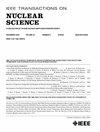一种主动个人可穿戴电离辐射剂量计和人类亚轨道太空飞行的结果
IF 1.9
3区 工程技术
Q3 ENGINEERING, ELECTRICAL & ELECTRONIC
引用次数: 0
摘要
IvmeRad是一种主动的个人可穿戴辐射剂量计。IvmeRad-S是由土耳其宇航员于2024年6月8日与维珍银河公司一起进行亚轨道太空飞行,高度为87,548公里的设备的改进版本。在持续70分钟的飞行中,对宇航员的辐射暴露进行了测量和分析。本文研究了盖格-米本文章由计算机程序翻译,如有差异,请以英文原文为准。
IvmeRad: An Active Personal Wearable Ionizing Radiation Dosimeter and Results From a Human Suborbital Space Flight
IvmeRad is an active personal wearable radiation dosimeter. IvmeRad-S is a modified version of the device that was carried by a Turkish astronaut on a suborbital space flight up to an altitude of 87,548 km on June 8, 2024, with Virgin Galactic. During the flight, which lasted 70 min, radiation exposure of the astronaut was measured and analyzed. In this study, the design and calibration of the Geiger–Müller detector alongside the performance of the integrated device are investigated, and data are presented and compared to Civil Aeromedical Research Institute 7A (CARI-7A), Model for Atmospheric Ionizing Radiation Effect (MAIRE), and QinetiQ Atmospheric Radiation Model (QARM) calculation codes. A comparison of different calculation codes shows different H*(10) ambient equivalent dose rate behavior above 20 km. These differences could be attributed to the high radiation weighting factor of heavy ions and modeling differences of incident ionizing particles. Also, dependencies on detector characteristics and calibration are discussed to compare calculations with measured dose rates.
求助全文
通过发布文献求助,成功后即可免费获取论文全文。
去求助
来源期刊

IEEE Transactions on Nuclear Science
工程技术-工程:电子与电气
CiteScore
3.70
自引率
27.80%
发文量
314
审稿时长
6.2 months
期刊介绍:
The IEEE Transactions on Nuclear Science is a publication of the IEEE Nuclear and Plasma Sciences Society. It is viewed as the primary source of technical information in many of the areas it covers. As judged by JCR impact factor, TNS consistently ranks in the top five journals in the category of Nuclear Science & Technology. It has one of the higher immediacy indices, indicating that the information it publishes is viewed as timely, and has a relatively long citation half-life, indicating that the published information also is viewed as valuable for a number of years.
The IEEE Transactions on Nuclear Science is published bimonthly. Its scope includes all aspects of the theory and application of nuclear science and engineering. It focuses on instrumentation for the detection and measurement of ionizing radiation; particle accelerators and their controls; nuclear medicine and its application; effects of radiation on materials, components, and systems; reactor instrumentation and controls; and measurement of radiation in space.
 求助内容:
求助内容: 应助结果提醒方式:
应助结果提醒方式:


